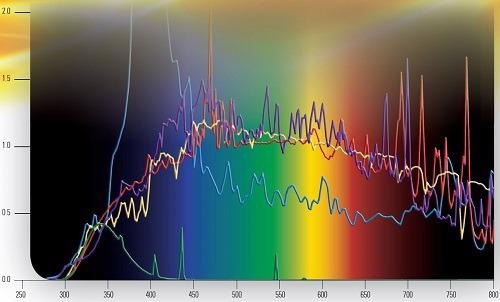Correctly filtered xenon-arc lamps can facilitate state-of-the-art simulation of worst-case solar radiation in the ultraviolet (UV) and visible (VIS) wavelength range (290 nm to 800 nm) – radiation that is ideal for weathering applications.

Xenon spectrum (red) compared to sun (yellow) and other light sources. Image Credit: ATLAS Material Testing Technology
Much like the sun itself, a xenon lamp emits UV and VIS light as well as a significant amount of heat energy. Some applications require the deliberate heating up of samples and some do not.
In either case, the lamp itself, its filters and surrounding components must be cooled to avoid issues like over-heating, which can cause damage and premature aging.
Much like the motor of a car, weathering instruments such as lamps and their surrounding components can be cooled using water or air, according to the requirements of the type of xenon lamp in use.
Instruments that are cooled using water - for example, the Ci-series Weather-Ometers - are typically called ‘water-cooled xenon instruments.’ In contrast, the Xenotest and SUNTEST families of instruments are widely-recognized examples of ‘air-cooled instruments.’

Ci3000 water-cooled (left) and Xenotest 220+ air cooled (right) xenon-arc instruments. Image Credit: ATLAS Material Testing Technology
The lamp cooling technology in use does not impact the cut-on of radiant energy or spectral irradiance distribution in the UV and VIS. The spectrum is highly controllable, particularly in the critical UV/VIS wavelength ranges, by using an appropriate optical filter system.
If appropriate optical filter systems are used, and the spectral irradiance distribution and irradiance level on the sample’s surface are identical, the type of lamp cooling will not affect the test results at all. This has been demonstrated a number of times via Atlas’ comprehensive spectroradiometer measurements.
Choosing Between Lamp Cooling with Water or Air
Some types of xenon weathering instruments use water for lamp cooling, while others use air. This is because the heat conductivity of water is 10-times higher than air. For example, swimming in a 15 °C pool will feel much warmer than walking in 15 °C air.
The Ci4400 Weather-Ometer employs a xenon lamp that features a nominal maximum power of 6.5 kW, while its Ci5000 counterpart employs a 12 kW xenon-arc lamp.
These high-powered lamps run at standard irradiance levels because the exposed samples will be situated further from the lamp than in smaller air-cooled instruments.
The heat conductivity of air is not sufficient to cool these high-wattage lamps and to ensure that the optimum operating temperature is maintained throughout the lamp’s lifetime. Water cooling is, therefore, required for these high-wattage lamps.
Air-cooled instruments such as SUNTEST and Xenotest use xenon lamps between 1.5 and 2.2 kW nominal power. These lamps can use lower wattages because they have a relatively smaller capacity, meaning that samples are closer to the xenon lamp. Air is an appropriate cooling agent for these instruments.

This information has been sourced, reviewed and adapted from materials provided by Atlas Material Testing Technology LLC.
For more information on this source, please visit Atlas Material Testing Technology LLC.